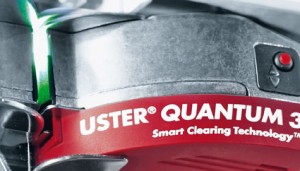 The launch in September 2010 of the USTER® QUANTUM 3 yarn clearer was a massive leap forward in range of capability, ease of use and customer benefits.
The launch in September 2010 of the USTER® QUANTUM 3 yarn clearer was a massive leap forward in range of capability, ease of use and customer benefits.
This new-generation system propelled yarn clearing into a new era, with its capability to suggest optimum cut settings automatically and its use of the YARN BODY concept to provide an instant quality reference. USTER launched the clearers globally and subsequently undertook a detailed review of customer experiences, based on practical use under mill conditions. Innovations were at the core of the USTER® QUANTUM 3 development. For the first time, a yarn clearer went beyond normal expectations – with its ability to propose clearing limits and predict cut levels. Foreign matter clearing was dramatically upgraded, with the ability to see colored defects and remove selectively the faults likely to affect fabric quality. Polypropylene detection capability was also extended to cover count variation and periodic faults. Simple, error-free clearing was the aim, with the ultimate goal of helping spinners raise quality and productivity. Initial reactions around the world were positive: customers were said to be quite impressed. Pre-launch testing had confirmed initial confidence in the product, but USTER determined to support this with practical evidence, visiting spinning mills to get first-hand feedback from customers across a wide range of mill environments, applications and quality requirements. Was the new clearer delivering the benefits customers needed? Feedback suggested it was, and that a new approach to yarn clearing was born.
Hard facts can spring surprises
Today – 33 month after the first installations, and with half a million USTER® QUANTUM 3 clearers sold – the facts have surprised even USTER’s own experts. The clearers are now installed in over 10.000 automatic winders around the world, in textile hotspots like China, India, Turkey, Pakistan, Bangladesh, Indonesia, Vietnam, Korea, Italy and Egypt, as well as in less-obvious markets such as Spain, Argentina, Guatemala, Tanzania, Russia and Uzbekistan. Mills range from first-time entrants in automatic winding to sophisticated users with very high quality demands. They span environmental conditions from 10 degrees Celsius to 53 degree Celsius, from 20 percent relative humidity to 80 percent. Over 300 fiber types were processed, including traditional cotton, polyester, viscose and their blends as well as flax, modal, Tencel, silk, cashmere, elastane and non-elastane core types. These facts prove USTER® QUANTUM 3 is flexible enough to handle varying conditions, applications and expectations. But what are the customer benefits in terms of quality and productivity? Optimal clearing limits: quickly and simply Customers were united in their appreciation of the YARN BODY concept, which made the system much easier to use. It was easy and fast to arrive at an optimal clearing limit – a factor which was always a matter for debate – with users now welcoming the YARN BODY as an essential element in yarn clearing. Many customers also reported the elimination of quality complaints, especially with more even yarns such as compact yarns. Previously, clearing limits had been unable to eliminate outliers for these yarns, as spinning mills often followed the ‘class clearing’ approach. The YARN BODY view made these faults much more obvious, and mills were able to adapt the limits accord ingly. The example below (fig. 1 and 2) from the USTER® CLASSIMAT 5 clearly shows the impact of this feedback. The yarn is a compact yarn, but clearing using traditional classes left some remaining outliers in the yarn, indicated by the dark green triangles – a special feature of the USTER® CLASSIMAT 5 yarn classification system. As a consequence of the YARN BODY view, spinners had moved closer to eliminating outliers without increasing the cuts significantly in such cases. There were also many examples of spinning mills defining clearing limits that were too close. Thanks to the YARN BODY visualization they could correct them resulting in saving waste and in increasing productivity, both leading to higher profits.
Identifying process disturbances
Some mill managers also reported they had implemented changes to their routines, so that they were now checking the YARN BODY randomly during patrols in the mill. “The YARN BODY is an indicator of process and raw material situation – if something was unusual in the shape or a larger light green area triggered, we could discuss some improvements,” explains a customer in Pakistan. A number of mills with higher quality demands also carried out trials to monitor the changes in the YARN BODY, using scatter plots to find process issues and suggest improvements. For example (fig. 3 and 4), a mill from India noticed an unusual number of events in the 8 cm to 32 cm area. This triggered investigations leading to optimum card ing speed settings and considerable improvement in cuts and fabric quality. This, and many other examples, underlined the value of the YARN BODY as a good parameter to gain an understanding of the yarn evenness and its variations, at a glance. The general rule is: the narrower the YARN BODY, the better the fabric quality. A comparison tool is now incorporated into the USTER® CLASSIMAT 5. While some mills reported initial difficulties in adapting managing the innovative multiple systems, the general reaction was a determination to improve and become more effective, even if this meant changes in procedures. “I have heard from many customers how much they value the easy use and the clearing limit proposals”, says Sivakumar Narayanan, Product Manager of Yarn Clearing, within Uster Technologies Ltd. “In fact, some customers told us they could hardly remember how they operated their yarn clearing installations before the YARN BODY concept with USTER® QUANTUM 3.”
 Tekstil Teknik Dergisi Tekstil Haberleri, Tekstil Sektörü, Tekstil Teknik
Tekstil Teknik Dergisi Tekstil Haberleri, Tekstil Sektörü, Tekstil Teknik




